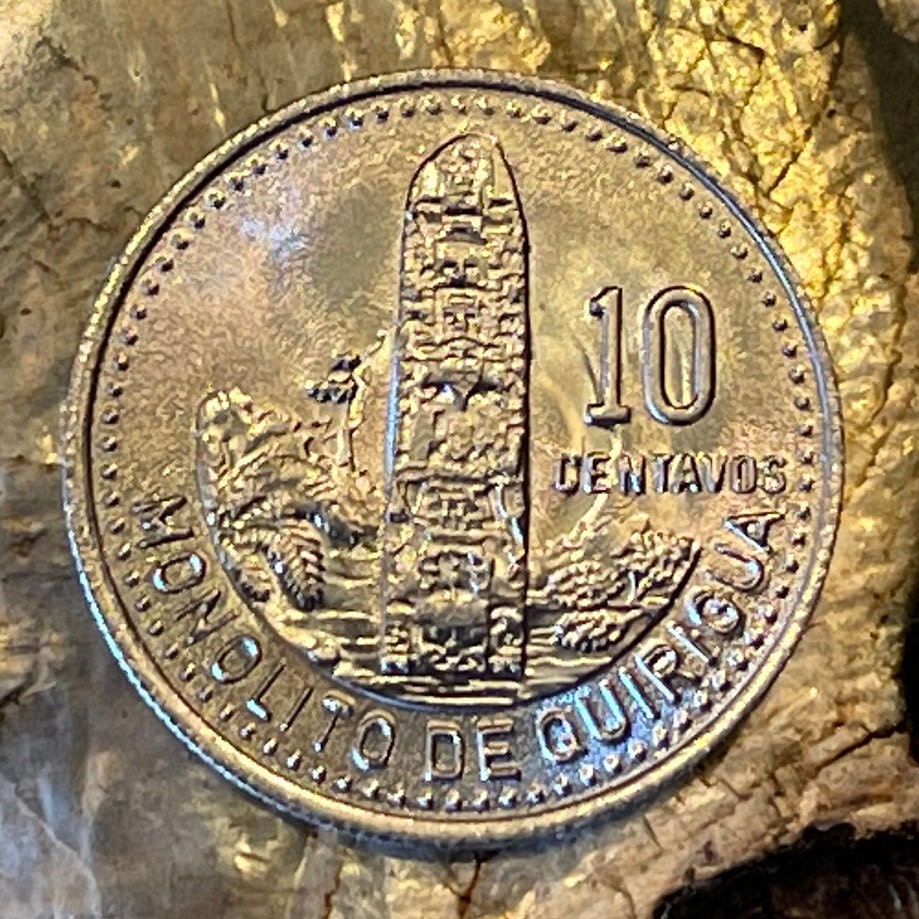elemintalshop
Maya King on Quirigua Monolith 10 Centavos Guatemala Authentic Coin Money for Jewelry and Craft Making
Maya King on Quirigua Monolith 10 Centavos Guatemala Authentic Coin Money for Jewelry and Craft Making
Couldn't load pickup availability
Maya King on Quirigua Monolith 10 Centavos Guatemala Authentic Coin Charm for Jewelry and Craft Making
Obverse: Coat of arms, with legend at top, and date at bottom.
Lettering: REPUBLICA DE GUATEMALA
LIBERTAD
15 DE
SETIEMBRE
DE 1821
Translation: Republic of Guatemala
Liberty
15 of
September
of 1821
2006
Reverse: Mayan Pillar ruins of Quiriguá with denomination at right and legend below. This stela bears portraits of K'ak' Tiliw Chan Yopaat on its front and back.
Lettering: 10 CENTAVOS
MONOLITO DE QUIRIGUA
Translation: 10 Cents
Quirigua monolith
Features
Issuer Guatemala
Period Republic (1841-date)
Type Standard circulation coin
Years 1976-2009
Value 10 Centavos
0.10 GTQ = USD 0.013
Currency Quetzal (1925-date)
Composition Nickel brass (61% Copper, 20% Zinc, 19% Nickel)
Weight 3.2 g
Diameter 21 mm
Thickness 1.25 mm
Shape Round
Technique Milled
Orientation Coin alignment ↑↓
Number N# 2259
References KM# 277
Wikipedia:
Quiriguá (Spanish pronunciation: [kiɾiˈɣwa]) is an ancient Maya archaeological site in the department of Izabal in south-eastern Guatemala. It is a medium-sized site covering approximately 3 square kilometres (1.2 sq mi) along the lower Motagua River, with the ceremonial center about 1 km (0.6 mi) from the north bank. During the Maya Classic Period (AD 200–900), Quiriguá was situated at the juncture of several important trade routes. The site was occupied by 200, construction on the acropolis had begun by about 550, and an explosion of grander construction started in the 8th century. All construction had halted by about 850, except for a brief period of reoccupation in the Early Postclassic (c. 900 – c. 1200). Quiriguá shares its architectural and sculptural styles with the nearby Classic Period city of Copán, with whose history it is closely entwined.
Quiriguá's rapid expansion in the 8th century was tied to King K'ak' Tiliw Chan Yopaat's military victory over Copán in 738. When the greatest king of Copán, Uaxaclajuun Ub'aah K'awiil or "18-Rabbit", was defeated, he was captured and then sacrificed in the Great Plaza at Quiriguá. Before this, Quiriguá had been a vassal state of Copán, but it maintained its independence afterwards. The ceremonial architecture at Quiriguá is quite modest, but the site's importance lies in its wealth of sculpture, including the tallest stone monumental sculpture ever erected in the New World.
.......Stela E stands in the northern half of the Great Plaza. This stela was dedicated on 24 January 771 by K'ak' Tiliw Chan Yopaat. Its total shaft measures 10.6 metres (35 ft) in height, including the buried portion holding it in place, which measures just under 3 metres (10 ft). This enormous monolith is the largest stone ever quarried by the ancient Maya and weighs approximately 65 tons, it may even be the largest free-standing worked monolith in the New World. In 1917 this stela, already tilting away from vertical, finally fell over completely after heavy rains, although it remained unbroken. In 1934 an attempt was made to raise the stela using a winch and steel cables, during which the cables snapped and the monolith fell and was broken into two pieces, which have since been joined back together using concrete. This stela bears portraits of K'ak' Tiliw Chan Yopaat on its front and back.
*******
Wikipedia:
The current coat of arms of Guatemala was adopted after the 1871 Liberal Revolution [es] by a decree of president Miguel García Granados. It consists of multiple symbols representing liberty and sovereignty on a bleu celeste shield. According to government specifications, the coat of arms should be depicted without the shield only when on the flag, but the version lacking the shield is often used counter to these regulations.
History
In 1871, for the 50th anniversary of Guatemala gaining independence, president Miguel García Granados asked the mint to produce a design to commemorate the event. The Swiss engraver Juan Bautista Frener designed the shield, and Granados decided to adopt it as the national coat of arms, abandoning the previous coat of arms which had conservative symbolism. In Executive Decree No. 33 of 18 November, the coat of arms was described:
The arms of the republic will be: a shield with two rifles and two swords crossed with a wreath of laurel on a field of light blue. The middle will harbor a scroll of parchment with the words "Liberty 15 of September of 1821" in gold and in the upper part a Quetzal as the symbol of national independence and autonomy.
The flag and coat of arms were further regulated in detail in a 12 September 1968 decree by the government of president Julio César Méndez Montenegro, specifying the elements, colors, and the specific shade of blue on the shield.
Symbolism
The elements of the coat of arms have the following symbolism:
The Quetzal is the national bird of Guatemala, and represents freedom and independence of the nation.
The crossed Remington rifles are the type used during the 1871 Liberal Revolution, and represent the will to defend Guatemala's interests.
The crossed swords represent justice and honor.
The laurel wreath represents victory.
The parchment at the center reads "Liberty 15 of September of 1821", the date Guatemala gained independence from Spain.
Share










Beautiful product, well packaged, quickly shipped and the perfect addition to our Mayan study in my third grade classroom. Thank you!
Wonderful piece. Great for my collection
5 stars review from Ernesto









